Конспект уроку "Одяг" 6 клас
Як відомо, одяг виникла майже разом з появою людини. Тепер – це невід'ємний атрибут нашого життя. Даний урок англійської присвячений одязі або clothes англійською. Дана тема важлива тим, що clothes – наш повсякденний атрибут, тому він часто-густо зустрічається в мовленні.
План конспект уроку з англійської мови у 6 класі за темою «Одяг»
Topic : Clothes
Objectives:
1. To practice pupils’ skills using “clothes”-words in their oral speech;
2. To practice irregular verbs and Past Simple Tense;
3. To motivate pupils’ cognitive and creative thinking;
4. To develop pupils’ communicative skills;
5. To develop the skills of listening, reading and speaking
Equipment: multimedia complex, work-sheets.
Procedure
 1.
Warming-up.
1.
Warming-up.
1). Greeting ( 1 minute ) T – Good morning, students!
Ss – Good morning, teacher!
T – Nice to meet you!
Ss – Nice to meet you, too!
T – What a lovely day today! Our lesson today is unusual. There is a picture on the board, but it is hidden. We’ll open it space by space by doing some interesting exercises. Ok? We continue to speak about “clothes”. So, let’s open the first space.
2 ). Lead-in ( 3 minutes )
T – Let’s play a game, which is called “The chain”. The first student says a word, which refers to “Clothes”. The second student repeats the first student’s word and adds his own word. The third has to repeat two words and add his one. Foe example, 1: Tshirt; 2: T-shirt, suit; 3: T-shirt, suit, blouse. […] T: Well done. Let’s open the next space.
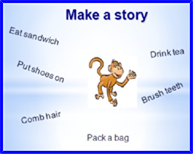 3). Speaking (5
minutes )
3). Speaking (5
minutes )
T – Now look at the board, please. Can you read these words?
S1 – Eat sandwich, comb hair, drink tea, put shoes on, brush teeth, pack a bag and a monkey.
T – Good. Isn’t it a funny combination? Let’s make a story using all these expressions. E.g.: A little monkey
got up early and drank tea…. You can think for about a minute. Ss – I ate sandwich went to school and met a monkey on my way! […]
T – Excellent. Well, I also try to do it and create a poem. So, you can easily learn it and get fun. Let’s read.
S2 - Eat your sandwich.
Drink your tea.
Comb your hair.
Brush your teeth.
Put your shoes on.
Pack your bag.
Get a key.
Say “Hello!” To your monkey.
2. Main part of the lesson.
1). Pronunciation (2 minutes )
T – We continue to open our picture and the next space contains a tongue-twister. Let’s try to say it.
Ss – She sells seashells by the seashore. The shells she sells are seashells, I’m sure! T – Super! Let’s try to pronounce it faster. […] as fast as you can […] Good job! The next space contains some games!!! It’s time to get some fun.
2). Practicing lexical material (5-7 minutes)
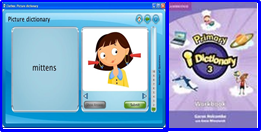 (A teacher may use computer CD disk with games «Primary
i-dictionary – 3.
(A teacher may use computer CD disk with games «Primary
i-dictionary – 3.
Cambridge University Press»)
T – Look, please, at the board. These are… Ss – Clothes.
T – Yes, let’s revise the words. Just repeat after me.
Ss – Belt, gloves, sunglasses, earrings, mittens, wellington boots, necklace, .
T – Good job. Now we’ll practise in spelling and writing the words. Then you can find a picture to a word. Be very attentive!
Ss – […]
T – Which space is the next? Let’s open it. Ss – Space number five!
3). Listening (5 minutes) .
T – It’s time to relax. Let’s listen to the song about fashion show. Listen careful and try to remember every trifle. […] Ok, these are the words of the song, but something is missing. Let’s recollect the words!
Chorus: Come on boys and come on girls! Answer Key
________ hair, ______ hair, lots of _______. straight short curls
Spotted _____ and shiny _____ tights rings
Our great, big fashion show begins.
Do you like my _______ and my striped _______? trainers shorts
We love your _______ and your striped _______! trainers shorts
Do you like my _______ and my striped _______? trainers shorts
We love your _______ and your striped _______! trainers shorts
Chorus:
Do you like my silver ________ and silver ________? uniform sunglasses
We love your silver ________ and silver ________! uniform sunglasses
 Do you like my silver ________ and silver ________? uniform
sunglasses We love your silver ________ and silver ________! uniform
sunglasses
Do you like my silver ________ and silver ________? uniform
sunglasses We love your silver ________ and silver ________! uniform
sunglasses
Chorus:
Do you like my striped ________, my ____and _____? tights belt gloves
We love your striped ________, your ____and _____! tights belt gloves
Do you like my striped ________, my ____and _____? tights belt gloves
We love your striped ________, your ____and _____! tights belt gloves
 Chorus: tights straight
curls belt uniform short shorts sunglasses
trainers gloves rings
Chorus: tights straight
curls belt uniform short shorts sunglasses
trainers gloves rings
4). Moving (4 minutes )
T – We’ve already opened six boxes and let’s open the seventh. It’s time to move. Please, stand up. You have already known a lot of irregular verbs and now we will do some exercises with them. Raise your hands – this is the first form of the verb, put your hands on your shoulders – this is the second form, and touch your knees – this is the third form. For example, a verb “to do” has got three forms: 1) do – raise your hands, 2) did – touch your shoulders, 3) done – touch your knees. Another example, a verb “to cut” has got three forms the same: 1) cut – raise your hands, 2) cut – raise your hands, 3) cut – raise your hands. Let’s start: “to come” (come, came, come), “to go” (go, went, gone), “to sleep” (sleep, slept, slept), “to do” (do, did, done), “to know” (know, knew, known), “to buy” (buy, bought, bought), “to have” (have, had, had), “to be” (be, was/were, been), “to read” (read, read, read), “to play” (played… Oops! It’s not an irregular verb!)
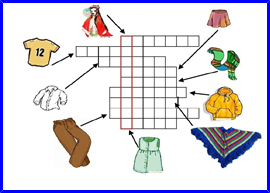 5). Crossword (2
minutes)
5). Crossword (2
minutes)
T – Now let’s write a little. This is a crossword-puzzle. Let’s check the spelling of the words. One by one, come to the board and write the words […]
Answer Key: costume, t-shirt, blouse, skirt, scarf, sweater, poncho, trousers, dress.
6). Exercises ( 5minutes )
T – Now, look at the words, find their definitions, please. […]
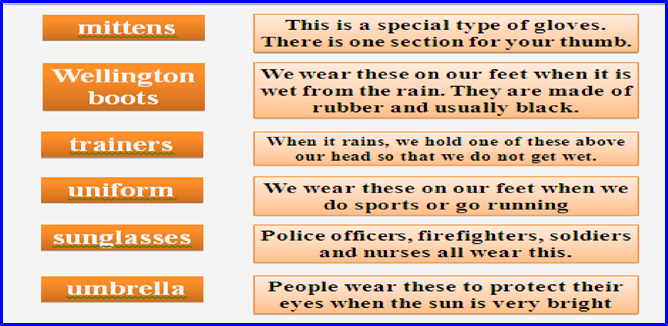
 T – Let’s check whether you can spell the words. There are
some words, but letters are mixed. Our task is to unscramble the words.
T – Let’s check whether you can spell the words. There are
some words, but letters are mixed. Our task is to unscramble the words.
Blet, wderunrea, shyin, tedpots, priedst, senttim, tepock.
Answer key: belt, underwear, shiny, spotted, striped, mittens, pocket.
7).Reading (5 minutes )
T – Perfect! We spoke and wrote, and sang a little, it’s time to read. This is a text for you, which is called “The English Lesson”. But it’s not finished – the last sentence has gone. Let’s read it one by one and think about the ending.
![]()
Ss – George was sitting in his class. It was a hot afternoon and he was feeling sleepy. It was a grammar lesson and George was also bored. He hated grammar. He wanted to leave school and work. He wanted to be a gardener. George loved flowers and trees. George looked out of the window. He looked at the trees and flowers. Then he started day-dreaming.
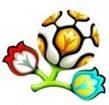
 After ten minutes the teacher stopped talking. She asked
the students to do a grammar exercise in their books. The students took out
their exercise books and their pencils and they started writing. The teacher
looked at George. She saw that he wasn’t writing so she said,
After ten minutes the teacher stopped talking. She asked
the students to do a grammar exercise in their books. The students took out
their exercise books and their pencils and they started writing. The teacher
looked at George. She saw that he wasn’t writing so she said,
“Why aren’t you writing, George?”
George stopped dreaming and said,
“What, Miss?”
“Wake up, George!” the teacher said. “Why aren’t you writing?”
George thought for a moment and replied,
“I ain’t got no pencil.”
The teacher looked at George and said,
“You ain’t got no pencil? You mean. I don’t have a pencil.”
George didn’t understand the English teacher so he said,
“Sorry, Miss.”
The teacher said in an angry voice,
“I don’t have a pencil. You don’t have a pencil. He doesn’t have a pencil. She doesn’t have a pencil. They don’t have a pencil. We don’t have a pencil. Now, George. Do you understand?”
George looked at the teacher for a moment and then he said, “………………………………………………………………..”
![]()
T – What do think, what did he say?
Ss – […]
T – That’s a good idea. In reality he said “My goodness, what happened to all the pencils, Miss?”
T – So, what is the hidden picture? Yes, it’s the symbol of the championship “EURO-2012” Let’s look what uniform different countries have. […] Just imagine the situation that you are young designers and your task is to create new uniform for our national team.
3. Ending the lesson.
Summing up ( 3 minutes )
T – Good job! Time is up! Unfortunately, we have to finish. I liked the lesson. What about you?
Ss – Yes, we did.
T – What did you like? Ss – […]
T – Your home task is to retell the story “English lesson” and finish the project. You worked really hard today and I have some marks for you […] Ss – Thank you.
T: Good bye!
Загальні висновки щодо ефективності проведеного уроку
Урок, проведений на мультимедійній дошці, викликає в учнів величезне захоплення і задоволення. Учні відчувають, що вчитель йде в ногу з часом. Адже сучасний урок з реальними, цікавими відповідній віковій категорії учнів, прикладами завжди викликає інтерес. Інтенсивний темп розвитку суспільства вимагає від вчителів самовдосконалення та розвитку, постійного пошуку творчих ідей та рішень, винайдення нестандартних методів та прийомів навчання. Творчий вчитель надихає на творчість. Адже недарма говорить китайська народна мудрість: «Скажи мені і я забуду, покажи мені і я запам’ятаю, дозволь зробити самому і я зрозумію!»
Урок за темою «Одяг» є швидким за темпом, охоплює всі види мовленнєвої діяльності та спонукає учнів активно приймати участь у запропонованих завданнях. Кожен учень знайде в цьому уроці завдання до душі. Хтось любить співати, хтось малювати, комусь подобається вирішувати кросворди, ребуси та головоломки. Дехто любить читати, а хтось складати розповіді чи вірші. В будь-якій комбінації учні вдосконалюють навички вживання лексичних одиниць за темою «Одяг». В учнів відроджується інтерес до вивчення іноземних мов. Застосовуючи творчий підхід, вчитель спонукає учнів до творчості. Учням, особливо середнього шкільного віку, завжди цікавіше на уроці, який має щось більше окрім підручника та зошита. Тому, я вважаю, засобами виконання саме творчих завдань, таких як складання історії про мавпу, розучування вірша, скоромовка, пошук кінцівки до розповіді «На уроці англійської мови», створення нової форми для збірної команди України з футболу та інші, очікувані результати досягаються в повному обсязі.
Список використаної літератури
1. George Woolard “Lessons with Laughter” – London: Heinle Cengage Learning, 1996. – 94p.
2. Herbert Puchta, Jane Arnold, Mario Rinvolucri “Imagine That!” – London: Helbling Languages, 2007. – 191p.
3. Herbert Puchta, Scott Thornbury “Teaching Grammar Creatively” – London: Helbling Languages, 2006. – 264p.
4. Ann Baker “Tree or Three” – Cambridge: Cambridge University Press, 2006. – 129p.
5. Jonathan Marks “English Pronunciation in Use. Elementary” – Cambridge: Cambridge University Press, 2007. – 166p.
6. Anna Wieczorek “Primary I-Dictionary. High Elementary” – An interactive picture dictionary – Cambridge: Cambridge University Press, 2011. – 166p.
7. Ворожейкіна О.М. «100 цікавих ідей для проведення уроку» - Х.: Вид.група «Основа», 2011. – 2-ге вид, перероб. – 225с.
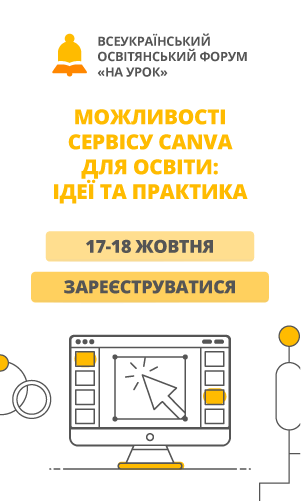

про публікацію авторської розробки
Додати розробку
